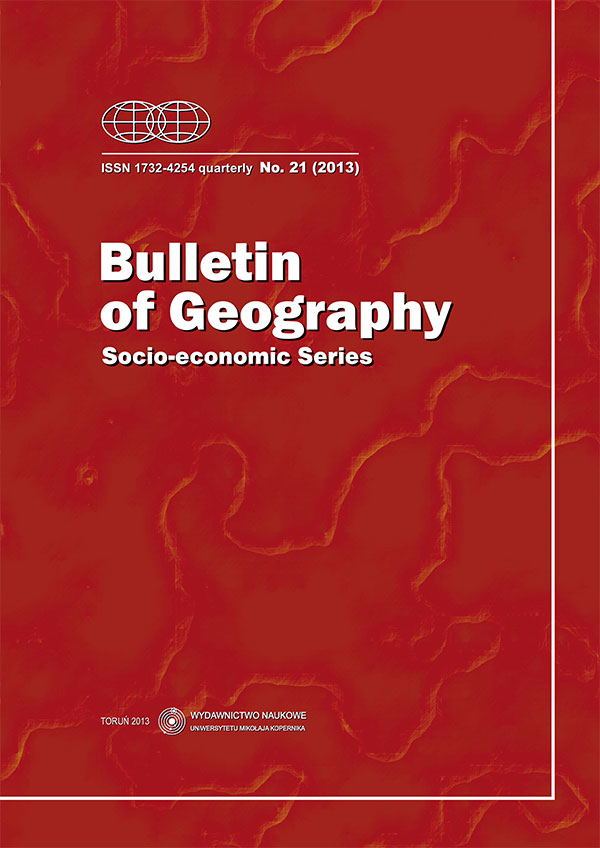Effects of transformations in the urban structure on the quality of life of city residents in the context of recreation
DOI:
https://doi.org/10.1515/bog-2013-0021Keywords
urban space, transformation, green areas, recreation, developmentAbstract
Accumulating over time, spatial transformations in Kraków have been changing the city’s structure. The contemporary image of the city is creating a new model of life and has a major effect on the functional and spatial conditions for its residents. Life in the city is dictated by the rhythm of daily routines, and the time of leisure has been reduced to a minimum. Less and less frequently are public and semi-private urban spaces used in the traditional manner and their number is decreasing. A considerable role in the decrease in the space for relaxation in the city is played by the purchasing power of money which is winning for itself the space for new residential estates. The disappearance of green areas can be best illustrated by the example of the green areas between Kraków and Nowa Huta. Historically, Nowa Huta was set up as an organism separate from Kraków. In 1956, Anna Ptaszycka presented a new plan for Kraków spatial development which curbed industrialisation and promoted Howard’s ideas of garden cities. In 1966, the largest park in that area was established, its basic function was to isolate Kraków from Nowa Huta and the steel plant there. As a result of the projects developed in recent years, the compact greenery is smaller, and more and more areas are being taken over for various projects. Spontaneous development of Kraków, without any master plans, for some small parts of city structure, is a huge threat to the preservation of existing leisure areas. Because of this, precise guidelines are needed for the intended use of areas neighbouring environmentally sensitive grounds, defining their type, scale and impact, in order to protect the landscape attractions which are amongst the desired recreational characteristics.
References
Dąbrowski, J. editor, 1957: Kraków – studia nad rozwojem miasta (Kraków – studies of city development – in Polish), Kraków: Wydawnictwo Literackie.
Ptaszycka, A., 1950: Przestrzenie zielone w miastach (Cities green areas – in Polish), Poznań: Ludowa Spółdzielnia Wydawnicza.
Bartkowicz, B., 1974: Wypoczynek codzienny mieszkańców nowych osiedli na przykładzie Krakowa (Daily leisure of population in new housing areas on the Kraków City example– in Polish), Kraków – Warszawa: PWN.
Bartkowicz, B., 1985: Wpływ funkcji wypoczynku na kształtowanie struktury przestrzennej miast (Influence of leisure functions in shaping the spatial structure of cities – in Polish). In: Monography, No. 33, Kraków: Politechnika Krakowska im. T. Kościuszki.
Budziłło–Dąbrowska, K., 1990: Wśród panoram Krakowa (Among the panoramic views of Kraków – in Polish), Kraków: Wydawnictwo Literackie.
Marx–Kozakiewicz, M., 2005: Szanse rewitalizacji przestrzeni osiedlowej – na tle projektów unijnych (Opportunities in the revitalization of the housing estate – against the background of EU projects – in Polish). In: Materiały Pokonferencyjne. Rola planowania przestrzennego w świetle polityki spójności Unii Europejskiej, Kraków: Politechnika Krakowska im. T. Kościuszki.
Szymańska, D., 2007: Urbanizacja na świecie (Urbanisation in the world – in Polish), Warszawa: Wydawnictwo naukowe PWN.
Szymańska, D. and Matczak M., 2002: Urbanization in Poland: tendencies and transformation. In: European Urban and Regional Studies, Copyright SAGE publications: London, Thousand Oaks, CA, New Delhi, pp. 39–46. DOI: http://dx.doi. org/10.1177/096977640200900104
http://fotopolska.eu/86262,foto.html, DoA: 27 August 2011, PM 3:00:32 CET.
http://planowanie.um.krakow.pl/bpp/, DoA: 14 September 2011, PM 4:18:16 CET.
Downloads
Published
How to Cite
Issue
Section
License
Title, logo and layout of journal Bulletin of Geography. Socio-economic Series are reserved trademarks of Bulletin of Geography. Socio-economic Series.Stats
Number of views and downloads: 588
Number of citations: 0



